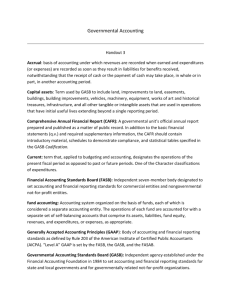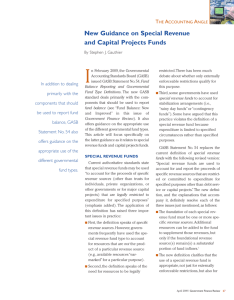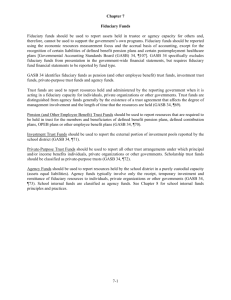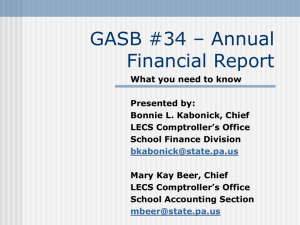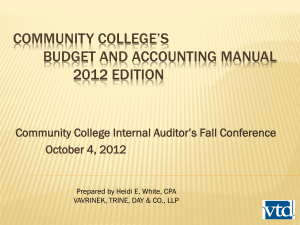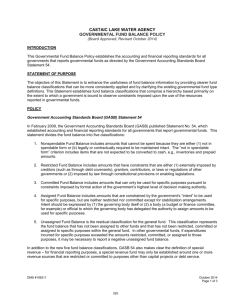Fund Accounting
advertisement
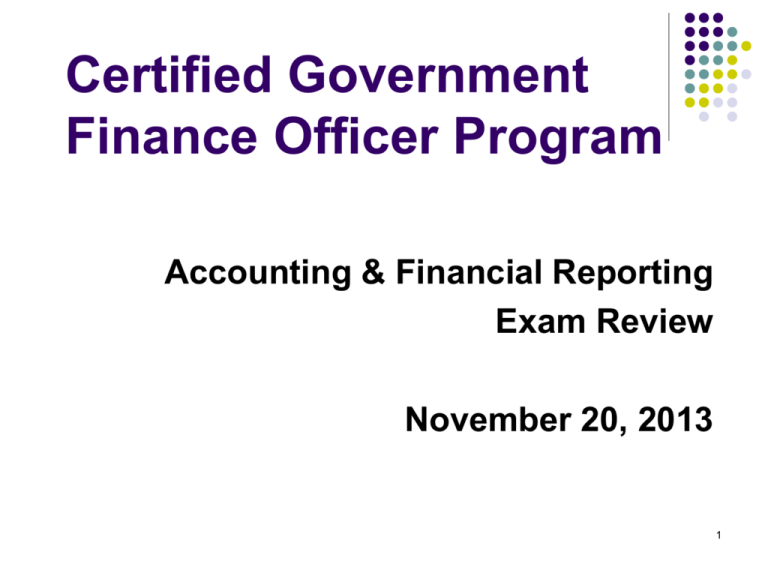
Certified Government Finance Officer Program Accounting & Financial Reporting Exam Review November 20, 2013 1 Accounting & Financial Reporting Exam Review PRESENTED BY: Kelly Rae Strickland, CPA, CGFO Deputy Finance Director City of Sarasota Kelly,strickland@sarasotagov.com Sarah C. Koser, CPA, CGFO, CPFO Deputy Finance Director The Villages Community Development Districts Sarah.Koser@DistrictGov.org 2 Overview Prepare you for the Exam. Increase your Professional body of knowledge. 3 3 Accounting & Financial Reporting Exam Review - Overview Question distribution accurate Questions updated & validated* References Documented Included in review materials 75 Questions Bank of 100+ questions Multiple versions of exam Test bank cross referenced to slides *2013 Update 4 Accounting & Financial Reporting Exam Review - Overview All questions multiple choice or true/false Can choose order to take parts of exam Plan your work & work your plan Review sessions do not replace individual study 5 Accounting & Financial Reporting Exam Review Topics Covered: 1. Accounting / Internal Controls / Capital Assets 30% 2. Financial Reporting (Internal & External) 30% 3. Auditing 15% 4. State of Florida Policies & Regulations 15% 5. CAFR 10% 6. Source Material N/A TOTAL 100% 6 Accounting, Internal Controls & Capital Assets 7 Overview Accounting Basics: Standard Setting in the U.S. Objectives of Financial Reporting Terminology Fund Accounting Measurement Focus Basis of Accounting 8 Overview Accounting Basics: Liabilities Debt Debt Refunding Capital Assets Budgets Odds & Ends 9 Standard Setting in the U.S. Financial Accounting Foundation – FAF Final authority (1973) for accounting & reporting standards in both the public & private sectors Appoints FASB & GASB board members Both establish accounting and financial reporting standards for respective constituents Currently addressing permanent funding options for GASB 10 Standard Setting in the U.S. Governmental Accounting Standards Board – GASB (1984/1989) State and Local Governments Governmental Not for Profits Financial Accounting Standards Board – FASB (1973) For-profit & non governmental Not for Profits SEC designee for issuers 11 Standard Setting in the U.S. Both use due process Discussion Memorandum, Invitation to Comment, Preliminary Views, Exposure Drafts, etc. made available to constituents Comments solicited & all submitted to board for consideration in standard setting deliberations Process really does work 12 Standard Setting in the U.S. American Institute of Certified Public Accountants (AICPA) Establishes audit & attest standards for non-issuers Officially recognizes FASB & GASB as authoritative standard setting bodies for Generally Accepted Accounting Principles (GAAP) in their respective sectors*. Role of the Federal Accounting Standards Advisory Board (FASAB) is intentionally omitted. *GAAFR 2012 Page 23 13 Standard Setting in the U.S. GASB #55 The Hierarchy of Generally Accepted Accounting Principles for State & Local Governments Effective Date: On issuance (March 2009) 14 Standard Setting in the U.S. GAAP Hierarchy (GASB # 55) GASB Statements & Interpretations GASB Technical Bulletins AICPA Industry Audit & Accounting Guides* AICPA Statements of Position* AICPA Practice Bulletins* Implementation Guides published by GASB staff *If made applicable & cleared by GASB 15 Objectives of Financial Reporting GASB Concepts Statement No. 1 Public accountability Information for decision making 16 Objectives of Financial Reporting Public accountability Sufficient current revenues for services Compliance Budget Finance-related legal/contractual requirements Service Efforts & Accomplishments (SEA) Other accomplishments 17 Objectives of Financial Reporting Public accountability Presumes taxpayers are entitled to know What government is doing & how What government did & how well What government plans to do & why Intergenerational/interperiod equity 18 Objectives of Financial Reporting Accounting data used for decision making Financial reporting should be: Understandable Reliable Relevant Timely Consistent Comparable 19 Objectives of Financial Reporting Primary Users of External Financial Reports Citizens Legislative and oversight bodies Investors and creditors 20 Terminology Fund Accounting – Definition Fund accounting is an accounting system emphasizing accountability rather than profitability, used by non-profit organizations and governments. In this system, a fund is a self-balancing set of accounts, segregated for specific purposes in accordance with laws and regulations or special restrictions and limitations*. *Leon E. Hay (1980). Accounting for Governmental and Nonprofit Entities, Sixth edition, page 5. 21 Terminology Asset Something owned by entity Liability Obligation of the entity Fund Balance Difference between assets & liabilities Revenue Fees charged for services Expenses Cost of providing services 22 Terminology Normal Account Balances: Debit balances for asset & expense/expenditure accounts Credit balances for liability, revenue & Fund equity accounts Debits must equal credits 23 Terminology Normal account balances: Typical debit balances Paid vacation leave Capital assets (in service) Typical credit balances Unpaid (accrued) vacation leave Fines & judgments (when known) Property tax revenue (any revenue) 24 Terminology Current Assets Used in operations or converted to cash within 1 year Capital Assets Benefit the organization for more than 1 year (service life) Includes intangible assets* *GASB #51 – Accounting for Intangible Assets – periods beginning after 6/15/2009 i.e. FY 2010 25 Terminology Current Liabilities Obligations due within 1 year (includes current portion of Long Term Debt) Non-Current Liabilities Obligations due more than 1 year hence 26 Terminology Total assets minus total liabilities Net assets Fund balance* Fund level for proprietary & fiduciary funds Fund level for governmental funds, i.e. unreserved fund balance Owner’s Equity (private business) *GASB #54 – Fund Balance Reporting and Governmental Fund Type Definitions Periods beginning after June 15, 2010 (FY 2011) 27 Fund Accounting (GASB#54) Nonspendable Fund Balance Cannot be spent because of: Form (e.g. inventory, prepaid assets) Must be maintained intact (e.g. principal of endowment fund) Restricted Fund Balance Externally enforceable limitations on use By creditors, grantors, contributors, laws, By law- constitutional or enabling legislation 28 Fund Accounting (GASB#54) Committed Fund Balance Assigned Fund Balance Limitation in place before end of period Limitation is self imposed (e.g. carryovers) Must be removed by same “highest level” that imposed it Limitation results from intended use “Intended use” delegated to lower level May be removed by same level that received delegation Unassigned Fund Balance Residual net resources Balance in excess of: Nonspendable/restricted/committed/assigned i.e. surplus 29 Fund Accounting Use “minimum number” necessary for management & accountability Three broad fund classifications: Governmental funds (5) Proprietary funds (2) Fiduciary funds (4) 11 fund types – (most important) 30 Fund Accounting Governmental Funds (5 types) 1. General To account for & report all financial resources not (required to be)* accounted for & reported in another fund Only fund required by GAAP Only one ‘General Fund” Small Local Government may have only a General Fund *GASB #54 – definition update drops this phrase 31 Fund Accounting Governmental Funds (5 types) 2. Special Revenue Account for & report the proceeds of specific revenue sources that are restricted or committed to expenditure for specified purposes other than debt service or capital projects 32 Fund Accounting Governmental Funds (5 types) 3. Debt Service Resources accumulated to pay long term debt Principal & interest 4. Capital Projects Acquisition/construction of major capital assets* i.e. not equipment units financed by proprietary funds 5. Permanent Resources restricted to extent that earnings and not principal may be used for support of entity programs *GASB #54 updates 33 Fund Accounting Proprietary Funds (2 types) 1. Internal Service Services provided by one agency, etc. to another on a cost reimbursement basis 2. Enterprise Operations financed & operated similar to private business i.e. user fees Accountability (not “profit “makers) 34 Fund Accounting Fiduciary Funds (4 types) 1. Pension Trust Fund Resources held in trust for others (Other Peoples Money) 2. Investment Trust Fund Pooled resources of legally separate entities Entity holds investments on behalf of others 35 Fund Accounting Fiduciary Funds (4 types) 3. Private-purpose Trust Fund Principal & income benefit specific individuals or organization 4. Agency Fund Pass-through funds (Other Peoples Money) e.g. utility deposits 36 Measurement Focus WHAT transactions are measured Economic resources Proprietary Current & fiduciary funds financial resources Governmental funds 37 Measurement Focus Economic resources (Proprietary & Fiduciary Funds) Measure inflows & outflows of economic resources Current (i.e. financial ) & noncurrent (i.e. economic) Capital assets & long-term debt Focuses on operational accountability Whether management efficiently uses resources in providing services 38 Measurement Focus Current financial resources (Governmental Funds) Measure inflows & outflows of current financial resources Cash & other liquid assets Payables from cash & other liquid assets Focuses on fiscal accountability Whether managers have met budgetary & other legal financial requirements 39 Basis of Accounting The technical term that describes the criteria governing the timing of the recognition of transactions and events is basis of accounting. Revenues are recognized when available and measurable Expenditures are recognized when: a liability is incurred the amount is determinable the liability will be paid from current resources 40 Basis of Accounting WHEN transactions are measured Accrual Modified accrual Cash 41 Basis of Accounting Accrual basis Recognizes the financial effects of transactions, events and interfund activities when they occur, regardless of the timing of related cash flows Revenues - When earned Expenses - When incurred Example - proprietary funds 42 Basis of Accounting Modified Revenues accrual basis When measurable & available 60 day criteria Expenditures Expected to be liquidated with current financial resources i.e. recognized in period governments liquidate the related liability rather than when the liability is first incurred. Example - governmental funds 43 Basis of Accounting Cash Recognizes transactions/events when related cash amounts received or disbursed Individual taxpayers 44 Basis of Accounting Measurement Focus Basis of Accounting Economic Resources Accrual Current Financial Resources Modified Accrual Proprietary fund statements Economic Resources Accrual Fiduciary fund statements Economic Resources Accrual Government wide statements Governmental fund statements 45 Liabilities Claims & Judgments Occurrence probable & reasonable estimate of amount is available TANs/RANs Tax anticipation notes Revenue anticipation notes Fund liability even if maturity exceeds 12 months 46 Debt General Obligation (GO) Bonds Voter approval No specific pledge other than “full faith & credit” Revenue Bonds Pledge of specified revenue source* or Restricted asset use or asset set aside Typically associated with enterprise borrowings but also used for governmental borrowings *GASB #48 – Sales and Pledges of Receivables and Future Revenues and Intra-Entity Transfers of Assets and Future Revenues 47 Debt GAAP generally requires recognition of expenditures when debt service payments are due Can recognize before due if due early in next FY and the following are met: Using a debt service fund Advance provision of resources is mandatory Payment due in short time period (one month maximum) Government-wide transactions Reconcile D/S expenditures to interest expense & reductions of LTD Accrual of interest 48 Debt Refunding Why done Lower market interest rate available Eliminate onerous bond covenants Free up current pledged revenues Types of refunding Advance Refunding Current Refunding 49 Debt Refunding Advance Refunding Old debt not yet callable New debt issued, proceeds placed in irrevocable trust/escrow to meet debt service payments of old debt Old debt technically outstanding until call date or maturity New debt proceeds = “other financing sources” Trust/escrow payments = “other financing uses” 50 Debt Refunding Current Refunding Old issue is callable & retired with proceeds of new debt New debt proceeds = “other financing sources” Payment of old debt = “debt service expenditure” 51 Debt Refunding Debt defeasance – advanced refunding In-substance defeasance Proceeds placed in irrevocable trust Liability removed (issuer contingently liable) Legal defeasance Proceeds placed in irrevocable trust Debt legally satisfied even though not repaid Matter of law 52 Debt Refunding Accounting Basics: Debt Refunding Arbitrage Practice of investing low-yielding tax-exempt bond proceeds in higher-yielding taxable instruments Highly technical area Liability recognition may be required 53 Capital Assets Capital assets Governmental funds Do not depreciate at fund level Reconcile from fund level to government wide level Proprietary & fiduciary funds Depreciate at fund level Depreciation at government wide level is arithmetic total of funds 54 Capital Assets Benefit is more than a single fiscal period Reported at: Actual/estimated historical cost Fair value (FV) if donated Interfund transfers at lower of Net Book Value (NBV) or FV 55 Capital Assets Special issues Infrastructure Post-closure care for landfills Immovable fixed assets Of value only to the government (GAAP) Modified approach (if used i.e. RSI) Recognized over life of landfill Intangibles* Easements; ”in-house” software *GASB #51 – Accounting & Financial Reporting for Intangible Assets - periods beginning after 6/15/2009 (FY 2010) 56 Capital Assets Special issues Leased assets Accounting at fund level Inception & subsequent Capitalized interest Proprietary & fiduciary fund assets only 57 Budgets Types of budgets Operating Budget Capital Budget Project Budget Cash 58 Budgets Operating Budget Adopted (legal) annual/biennial budget Typically “fixed” Formal amendment required to change Capital Budget Linked to Capital Improvement Plan (CIP) Can be multi-year Current year can be incorporated into operating budget 59 Budgets Project budget Adopted for length of specific project Can be multi-year Current year can be incorporated into operating budget Cash budget Operating budget Capital projects 60 Odds and Ends Reporting entity GAAP Statement No. 14 Statement No. 39 Primary States/local governments government General or special purpose Including fiduciary funds Component units Financial accountability 61 Odds & Ends Reporting entity: Primary government is financially accountable for another organization if It appoints a voting majority of the organization’s governing board AND It can either Impose its will on that organization OR Potentially provide specific financial benefits to or impose a financial burden on the other organization 62 Odds & Ends Reporting Entity If Primary Government DOES NOT appoint majority of governing board, it is financially accountable for another organization if other organization: Is fiscally dependent on Primary Government OR Holds economic resources entirely/almost entirely for PG AND PG entitled to/has ability to access majority of economic resources being held by other organization AND Resources being held are significant to PG 63 Odds & Ends Reporting Entity A Joint Venture is/has: Contractual agreement Joint control of assets On-going financial relationship Not a component unit 64 Odds & Ends Non-Exchange transactions include: Derived Tax Revenues Imposed non-exchange revenues Property tax (Ad valorem & personal), fines Government mandated non-exchange transactions Sales tax, income tax, fuel tax Formula grants Voluntary non-exchange transactions Reimbursement grants & donations 65 Odds & Ends NEW STATEMENTS: GASB # 57 - OPEB Measurements by Agent Employers and Agent Multiple-Employer Plans GASB # 58 - Accounting and Financial Reporting for Chapter 9 Bankruptcies GASB # 59 - Financial Instruments Omnibus GASB # 60 - Accounting and Financial Reporting for Service Concession Arrangements 66 Odds & Ends NEW STATEMENTS: GASB # 61 - The Financial Reporting Entity: Omnibus—an amendment of GASB Statements No. 14 and No. 34 GASB # 62 - Codification of Accounting and Financial Reporting Guidance Contained in Pre-November 30, 1989 FASB and AICPA Pronouncements GASB # 63 – Financial Reporting of Deferred Outflows of Resources, Deferred Inflows of Resources and Net Position GASB # 64 – Derivative Instruments: Application of Hedge Accounting Termination Provisions – an amendment of GASB Statement No. 53 67
